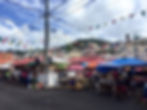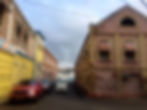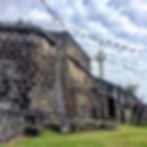Caribbean: Highlights of Grenada
- Giselle
- Apr 23, 2020
- 10 min read

The Caribbean island of Grenada, nicknamed the Spice Island, is a laid-back location for winter sun and summer fun. We stayed at True Blue Bay Boutique Resort, a family owned and operated hotel on the South Coast, with an excellent restaurant, several swimming pools, and a host of facilities, from water sports providers to a spa, on-site. This unique and colourful resort is set among tropical gardens and overlooks the waters of True Blue Bay.
From here, we explored as much of Grenada as we could fit in, while still finding time to lounge on the beach or by the pool. Our highlights are below, in no particular order, but if you mapped them all it would be close to a complete circuit of the island.
Grand Anse Beach

On the south-western edge of the island, Grand Anse is Grenada’s primary (and busiest) beach, partly due to its proximity to St George’s and the cruise ship port, but mainly because of its three-kilometre stretch of sheltered golden sand leading to turquoise water that quickly slopes to waist-depth. The super-fine sand is clean, shade is provided by trees dotted along the shore, and the water is pleasantly refreshing, as are the cocktails on the menu of the numerous low-rise hotels and bars minutes from the shore. The most popular watering holes include Umbrellas Beach Bar, mid-way along the beach, by the Coyaba Beach Resort and the hole-in-the-wall bars at the Craft & Spice Market towards the northern end – Esther's Bar is the pick here, offering potent mojitos and rum punches, as well as fruit punches made from scratch with local produce. Grenada’s not big on coffee, so caffeine addicts may want to detour inland slightly at the southern end of the beach, to find Bella Milano, which brews a reasonable cup of Joe. Naturally, there are numerous alternative beaches to choose from, should you wish to escape the crowd.
St George’s

The historic capital of Grenada, St George's, is a colourful jumble of buildings rising above a horshoe-shaped, natural harbour, protected by the rim of an old volcanic crater. It’s a pretty little place, worthy of a wander. Start at the Carenage, the waterfront promenade that winds around the harbour. Lined with colonial-era buildings, the inlet is encircled by shops, restaurants, and cafés. Keep an eye out for the statue of Christ of the Deep, commemorating the Italian cruise liner Bianca C, which caught fire and sank in the harbour in 1961. The Bianca C itself, known as the 'Titanic of the Caribbean', is a highly regarded wreck dive; the 180-metre-long cruise liner sits upright on her keel in 50 metres of water.

Don’t miss The House of Chocolate while you’re in town. This café, shop and mini-museum is dedicated to the history and production of cocoa and chocolate. Museum displays cover cocoa-growing and chocolate-making on the island from colonial times through to the present day, with several hands-on exhibits and activities. The shop sells locally made chocolate bars, along with cocoa nibs, cocoa powder and several non-chocolate-related souvenir items. It’s worth sitting down here for a chocolatey treat – sample the delectable homemade truffles washed down with a hot chocolate, or for something different, a cup of slightly bitter chocolate tea, made with coconut milk.
Grenada’s main market is here, too, in Market Square. Saturday morning is the busiest time, with vendors hawking fruit and vegetables, necklaces made from spices, packaged nutmeg, cloves and cinnamon, coconuts ready to drink, and the like.

St George’s is also home to three forts: Fort George, Fort Frederick and Fort Matthew. Fort George is closest to the centre of town. It’s a small bastion tracer fort that has been in constant use in one form or another since it was built (1706 – 1710). Currently, it houses the Royal Grenada Police force, but sections are open to the public and the views are worth the rather steep climb.
Fort Frederick, even further uphill from St George’s, was started by the French to secure their position after they captured the island from the British in 1779. It’s the best-preserved example of a European fortification on the island and again, is a superb vantage point from which to view St George’s, the harbour, and the current prison. Fort Frederick is right next door to Fort Matthew, the largest fort on the island. Fort Matthew is arguably the most interesting – if you’re into dilapidation. It was once used as an insane asylum and many of the cells and tunnels are recognisably extant.
Grand Etang National Park

A half-hour drive from Grand Anse is the Grand Etang National Park. There is a visitor information centre with information on the geology, nature and wildlife of the area, but the main reason people stop here is to spot the Mona monkeys, believed to have arrived on Grenada in the 1700s on slave ships from Africa. They often play and scavenge in the car park near the visitor centre. If there are none to be seen, they are likely near the road heading to Grand Etang Lake, which is a water-filled crater of an extinct volcano. There’s one particularly friendly male, George, who will happily use you as a climbing frame in exchange for a banana.
Grand Etang’s green spaces are set over the rising peaks of the central highlands. There’s plenty of trails for hiking, but they are largely unmarked, with the exception of the Mount Qua Qua hike. This is a moderately challenging trail that follows the volcanic crater ridge to the west of Grand Etang Lake, offering beautiful views across rainforest to Grenada’s east and west coasts. The good news is that there’s nothing venomous in the undergrowth, but make sure you are well-prepared and equipped.
Seven Sisters Waterfalls
The Seven Sisters Waterfalls are not the easiest to get to using public transport, but by the same token, the hike is not as complex as insinuated. The trail starts a couple of miles north-east of the Grand Etang visitor centre – keep your eyes peeled for the sign for the parking area by the road. Next to the visitor’s hut in the car park, you’ll see several walking sticks leaning against the fence – it’s worth borrowing one of these for the walk.

From the hut to the falls it's a good 30-minute hike, depending on recent weather conditions. Most people hire a guide and there are always a few lurking around if you so desire. The path isn’t overly difficult to follow independently either, although the trail can get muddy and occasionally slippery, so wear decent walking shoes. It starts on a road that winds through a cultivated area of nutmeg trees and taro, before heading into the jungle. The hike weaves through vibrant green foliage, at some points no wider than a goat track. Towards the end, there is a small river to rock-hop across. From there it’s a short ascent to the upper falls, where the waterfall is some 10 metres high, falling into a deep, pleasantly refreshing pool – it’s well worth a swim here.
There’s also a a canopy obstacle course set in the rainforest overlooking the falls if you are travelling with a group, but you’ll need to book in advance through Grenada High Wire.
If you’re after a waterfall that’s easier to access, Annandale Falls, 15 minutes closer to St George’s, is set in lush gardens only a two-minute walk from the visitor centre. It’s undeniably pretty, with a deep pool good for swimming, but it also receives a large number of visitors – particularly when a cruise ship is in port. Be warned.
Pearls Airport

If, like me, you’re fascinated by abandonment, Pearls Airport is a must-see. Heading north from Grenville along the northeastern coast, you’ll find it. This was Grenada’s first airport, but it hasn’t been used for commercial service in years. Pearls Airport was abandoned following the U.S. invasion in 1983. Now, it’s a cemetery for a Soviet crop duster and an old Cubana Airlines plane. The two planes are slowly disintegrating in a fenced off grassy area, next to the old runway. There are a few houses hugging the edge of the runway now and cows and goats graze on the verges, while cars use the runway as a shortcut. Apparently it’s also used as a (sanctioned) strip for drag racing.
On the block next door to the planes there are a load of crumbling cars and some forlorn-looking buildings. These were the terminal buildings and apparently are now police propery, with the cars being seized and clearly never returned.
Belmont Estate

Belmont Estate is a 300-year-old, 400-acre estate that dates back to the first French settlers arriving on Grenada. It was a coffee and sugar producer before changing to nutmeg and cocoa in the 1800s. Nowadays, while still a producer, it is also an agritourism offering with educational, half-hour tours, a restaurant, tropical garden, plant nursery and a goat dairy, with the milk used to produce organic cheese. There’s also a more extensive bean-to-bar tour that needs to be booked in advance.
Swing by the gift shop to stock up on chocolate and cocoa products before you leave.
River Antoine Rum Distillery

Dating from 1785, the River Antoine Rum Distillery is the oldest functioning water-propelled distillery in the Caribbean. The privately owned distillery uses much the same processes as it did back in the 1800s, with a water-driven wheel powering the crusher into which the cane is transported by a wooden conveyor. Large piles of bagasse – cane residue – are strewn around the distillery grounds, left to dry. It is later used as a fertiliser for local agricultural fields and a heating source in the distillery’s boiler house. The cane juice, in the meantime, runs through filtering screens before being deposited into a series of boiling caldrons, turning to syrup. This is then fermented naturally in a concrete vat before being distilled.
The rum is all sold on the island, testament to its popularity. That and the fact that Rivers Royale Grenadian Rum is not allowed to be taken on planes due to its flammability.
The Grenada Chocolate Company's Factory

If you think once chocolate producer is enough, think again. The Grenada Chocolate Company was founded in 1999 and created the first “Tree to Bar” chocolate this century. The factory is in a picturesque lime-green house in the village of Hermitage. One compact room is allocated for each of the chocolate-making tasks: sorting, winnowing, packaging, and so on. Tours are free, but tipping is appreciated. There’s also a factory outlet store in a boucan – a cocoa-drying shed – a couple of doors down from the factory.
Welcome Stone

The Welcome Stone is a short, pleasant walk to a spectacular viewpoint on the north of the island. If you’re navigating there solo, head towards Levera Hill on Madeys road, past Cedars Haven Holiday Apartment, then follow the left branch when the road forks. At the top of the hill there’s a not-so-attractive radar station surrounded by a wire-mesh fence. Park here, then on foot, follow the perimeter of the fence until the path leads down into the woods. The walk is only about a kilometre long, but there are some steep sections and it can be slippery underfoot. When you see a gathering of large boulders on the right, climb over them and you’ll find an impressive view of the coast, Sugarloaf, Green Island and Sandy Island, and further northeast, the islands of Caille, Ronde, Les Tantes and Diamond. On a clear day, you might catch a glimpse of Carriacou, one of the three main islands that make up the nation of Grenada. In case you’re into geography quizzes, Grenada and Petite Martinique are the other two.
Gouyave Nutmeg Processing Station

If you’ve gone bean to bar and washed it down with rum, it’s time to drop in to the Gouyave nutmeg processing station, one of three processing stations in Grenada. The nutmeg crop was decimated by Hurricane Ivan in 2004, but is now making a comeback. The 15-minute tour through the pungent station goes over the nutmes drying and sorting process. Mace, the outer husk of the nutmeg seed, is removed by farmers before the nutmegs are transported to the processing station. It’s used as a cooking spice and in cosmetic, but not, as many may believe, in pepper spray. The shop at the entrance of the processing station sells mace and nutmeg products.
The Underwater Sculpture Park
Whether diving or snorkelling, there’s one thing that HAS to be on your Grenada list – the underwater sculpture park. The Molinere Bay Underwater Sculpture Park, created by Jason deCaires Taylor, was a response to storm damage from Hurricane Ivan. Taylor created 75 sculptural works that are now in sand patches and gullies between natural rock formations at a depth of 5.8 metres. The structures provide a base for marine life to proliferate, a process that has already begun: one sculpture lying in the sand has a soft coral growing from its face. The Sculpture Park is listed as one of National Geographic’s 25 Wonders of the World for good reason. It’s arresting to behold.

There’s a sense of humour evident in some of the pieces – divers can take a selfie next to the Selfie Statue – a woman sitting on a bench. Other pieces are a social commentary: The Lost Correspondent is a man working at a typewriter, his desk covered with historical newspaper cuttings including some documenting Grenada’s involvement with Cuba; Vicissitudes is a circle of life-size figures cast from local children linked by holding hands. All are stunning and somehow surprising in their rippling underwater locale.
West Indies Beer Company

The West Indies Beer Company is in the south, towards Lance Aux Epines. There’s a big sign on the right hand side of the road next to an orange wall, leading to the superb brewery bar and beer garden. The company started in a wooden hut in True Blue Resort, eventually scoring the first brewery license issued in Grenada for over fifty years. They moved to their current location in 2016, where a queue of beer taps lines the bar. There are way too may beers (and ciders) to choose from. The easiest is to have a chat with one of the friendly bartenders about your beer preferences and let them supply a few samples to guide you along the way. That, or commit to a beer flight and enjoy the ride. If all that drinking makes you hungry, a pub grub menu is available up until midnight.
Oil Down and Goat Curry
Chocolate, rum, beer and nutmeg may not be enough to sustain you. There are a plethora of food options on the island, from the immensely popular, weekly Street Food Wednesday event at Dodgy Dock Restaurant at True Blue Bay Resort to the Sunday lunchtime BBQ at The Aquarium at one end of Magazine Beach and high-end Caribbean fusion at Sails Bar and Restaurant. There are two local dishes, though, not to miss.

Tender goat meat in a coconut curry is the signature dish at BB’s Crabback, a laid-back eatery in St George’s. This is not a gimmick – Bb’s specialises in bona fide Grenadine cuisine and comes recommended by locals.
The other one to try is Grenada’s national dish, Oil Down. This one-pot stew features breadfruit, callaloo, chicken, pork, dumplings, banana, turmeric, and coconut milk. Its name supposedly derives from the coconut milk simmering down and releasing its rich oil into the pot. This is true comfort food: hearty and flavour-packed, or at least, the one we tried at Good Food Restaurant in Grenville was. Delicious.













